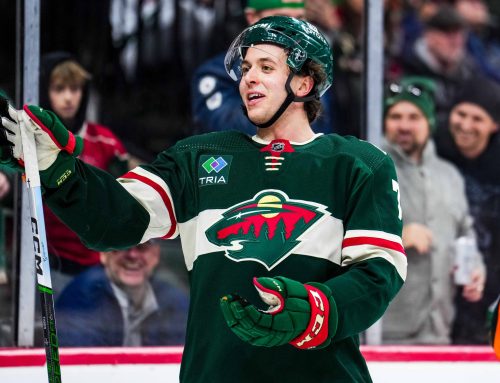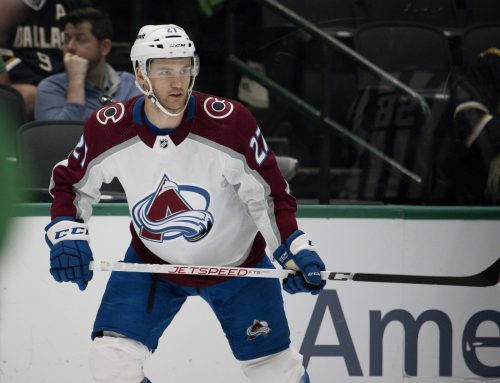Welcome back to Goldipucks and the Three Skaters, a play on words of the Goldilocks and the Three Bears story. Here though, instead of there being three bowls of porridge, I’m covering three skaters and declaring one too hot (i.e., doing unsustainably better than he should), another too cold (i.e., doing unsustainably worse), and a third “just right” (i.e., producing where he should be). I also assign each a rating of 1-10, indicating just how hot (rated 7-10, where 10 is the most unsustainably hot), or how cold (rated 1-4, where 1 is the most unsustainably cold), or how “just right” (rated 4-7, where 5.5 is the most “just right”) he is.
Because this is the final Goldipucks column before the end of the regular season, the players covered in this installment (Tyler Bertuzzi, Rasmus Dahlin, Victor Olofsson) are on teams (Detroit and Buffalo) out of the playoff hunt, as this way you can make mental notes of how they're trending to use when it comes to drafting or keeping them for next season.
The second-generation NHLer went from being the 58th pick in 2013 to the NHL for a cameo by 2016-17. He dressed for 48 games in 2017-18 and posted a point per every other contest, earning a full-time roster spot. From there, his play improved such that Detroit, eager for offense, installed him in the top six last season, with him responding to the tune of a full season scoring pace of 53 points. For 2019-20, he started superbly, then he slowed, but has been scorching of late, such that his full-season scoring pace is now back up to 56. Is Bertuzzi going to be a ~55 point player, or might better things be in store for the 2020-21 campaign? The answer could be neither, as signs suggest his scoring rate could drop.
Whereas last season Bertuzzi finished strong, with 25 points in his final 31 games while firing 72 pucks on net, this season he's flipped the script and his scoring and SOG rates dropped from Q1 to Q2 to Q3. And although his overall ice time also shrank during each of these quarters, it was still well above what he was getting at any point last season, so there should be no excuse for the slowdown. Moreover, in terms of his PP Time per game, it's more than double his 2019-20 rate and the good news is he's producing well with the man advantage; but that also means his P/60 rate at 5×5 is subpar, placing him barely within the top 150 NHL forwards who've played 40+ games this season.
Bertuzzi's IPP also is right at 62% for the second straight season, stressing that he's a complementary player who relies on others to drive offense and doesn't insert himself into the scoring picture. There's added concern in that his IPP hasn't climbed despite playing more than two-thirds of his even-strength shifts with Dylan Larkin, who's own IPP has dropped significantly. In short, Bertuzzi could be blamed for Larkin's scoring output suffering, since last season's successful Larkin played far less frequently with Bertuzzi. That could mean a one-way ticket for Bertuzzi off the top line, which is where nearly all of Detroit's offense is generated.
Lastly, with Detroit looking like it will not be a strong team for at least several years, the brass could try to revamp its approach to try and stress a defensive game, figuring it has been unable to succeed when trying to keep up offensively with its opponents. That'd be bad news for all its scoring forwards, but more so for Bertuzzi, who, as noted, appears to be unable to generate offense himself.
With Bertuzzi perhaps being "blamed" for dragging Larkin down this season, there's a good chance the two get separated for 2020-21, especially since Detroit has no shortage of young talent eager to snatch up a top-line role. As such, I believe his full-season scoring pace of ~55 points is TOO HOT, as it is based primarily on his hot start and doesn't reflect his shrinking scoring and SOG pace, as well as him shedding ice time. Given the team, he plays for and all these factors, I'd peg him as closer to a 50 point player next season, which means he gets an 8.0 rating.
To say Dahlin made an immediate impact as a rookie would be a vast understatement, as he became the first 18-year-old rearguard to best 40 points since Phil Housley nearly 30 years ago. This season he's seen his scoring rate rise, dodging the defenseman sophomore slump. But what do the cards hold for the future? Probably more of the same……for the near term.
Looking at Dahlin's stats, his 18 PPPts and loads of assists seem great and suggest he should be able to score at better than his 54 point current full season pace. But the issues are he's shed a great deal of ice time and become far more selective of a shooter.
In terms of SOG, Dahlin went from a rate of 2.15 per game as a rookie to this season just 1.53 per contest. That's concerning in and of itself; however, should he continue to shoot at such a low rate going forward, past data suggests it'll put a ceiling on his production. After all, from 2000-01 through last season, there were 110 instances of defensemen who scored at least 54 points in a season, yet among them, only 14 averaged even fewer than two SOG per game, and just one had a lower rate than Dahlin's this season, with a mere two of the 14 being under the age of 28 in the applicable season(s). So it seems until/unless Dahlin shoots the puck more, he will have difficulty upping his scoring.
There's also the issue of his ice time, which has shrunk by two minutes per game to now an average of 19:20 per contest. Projecting that to an 82 game season, it translates to 1585 minutes played – and that's assuming no games missed due to injury. How many of the 110 mentioned above played under 1600 minutes when they scored over 54? Try six, each of whom averaged more than two SOG per game in the applicable season(s), with four at 2.6+.
Digging even deeper, Dahlin's IPP sits at 57.6%. That is undoubtedly high; however, it is due in large part to his prowess with the man advantage, where he scores nearly half his points. If this figure was to drop, it likely would be due to his team scoring more at even strength, in which case it would be a wash in terms of his overall scoring rate. So no real concern there.
No question Dahlin has already shown he's a talented player who has the potential to be a superstar. Look no further than his rookie scoring to demonstrate the rarified air in which his skills put him. But for the near term, with him not shooting much nor logging tons of ice time, his supreme talent can only lead to him producing so much, and that so much is likely right at or near his 54 point current full season scoring pace.
So for 2020-21 at least, he's JUST RIGHT and gets a rating of 5.5. But come two or three years from now, a huge breakout could be in the cards, so I'd use this chance to try and get Dahlin from an owner who might be thinking perhaps he won't be as spectacular as thought when in truth it's likely just a matter of time before he explodes.
Although drafted in 2014, Olofsson didn't make it North America until 2018-19, after three seasons in the Swedish Hockey league, where his stats were good but far from superb. But he acclimated to pro hockey here quite well, posting 63 points in 66 AHL games, topped off by four points in a six-game cameo with the Sabres, which was more than enough to ticket him for the NHL for 2019-20. And Olofsson hasn't disappointed this season, storming out of the gate with PPG after PPG, and, contrary to what many expected, not falling off the fantasy radar as 2019-20 continued. How does all this bode for the future? Well…..quite well.
By now readers of my column know that past history, although admittedly not always predictive of future results, does – in my opinion – give as good a window into a player's trajectory as at least certain other metrics. How does history look for Olofsson? Pretty darn superb, as projected over a full season he'd have 0.77 points per game, 17 PPGs, and 2.3 SOG per contest, all as a rookie. If we go back to 1990-91 and look at rookies who met or exceeded all three criteria, we get a total of one – a guy named Alex Ovechkin, which is a mighty fine company in which to find oneself!
Beyond that, the chemistry between Olofsson and Jack Eichel is for real, as the 14 PPPts they have shared is within the top ten in man-advantage point pairs among all NHLers; and that's despite Olofsson having missed over 20% of his team's games this season. But lest you think Olofsson is only a man advantage specialist, keep in mind that his PP scoring has actually dropped with each quarter, meaning he's also finding ways to hit the score sheet at even strength.
Looking also at Olofsson's IPP, it's only 62.1%, which leaves room for realistic growth either via a higher percentage or as Buffalo's team goal-scoring improves, which it is on pace to do for the second straight season despite the fact they still sit in the bottom third of the league in that area. Long story short, Olofsson should see higher scoring via a higher IPP and/or due to his improving team, on which he's a top line and top PP fixture, further benefitting his offensive output.
Beyond all this, there's the opportunity factor. After Jeff Skinner had a great 2018-19 and then signed a huge deal to stay with Buffalo, pundits figured he'd be stapled to Eichel. Yet for the most part, the Sabres haven't been afraid to relegate Skinner to the second or even third line to allow Olofsson to stay on a line with Eichel. And it's not only allowed Olofsson to thrive but is helping lead Eichel to his best season as a pro. And with no one on the current roster, nor any near term prospects, poised to unseat Olofsson, one would think he'd continue to be deployed alongside Eichel, where over time he should only see more and more points. And even when they are separated, as occurred over the weekend, Olofsson was able to hit the score sheet and Skinner, playing with Eichel, went pointless yet again.
So although Olofsson was not initially a highly touted prospect, he's 100% for real and looks to be only scratching the surface in terms of his scoring. Accordingly, he's TOO COLD and should be counted upon for 70+ points next season if, as expected, he keeps his plum gig with Eichel, and based on sharing rookie accomplishments with Ovi. His rating is 2.75 and I would not be shy about trying to get him in leagues where his owners might be worried about his recent slowdown, which is likely due to coming back from injury or hitting a rookie wall.
************
Questions for Mailbag column
The next mailbag will be coming in just a couple of weeks, so be sure to send me your questions soon. To get them to me, you can either private message “rizzeedizzee” via the DobberHockey Forums or, instead, send an email to admin@dobbersports.com with “Roos Mailbag” as the subject line.





 FLA
FLA TOR
TOR CAR
CAR WPG
WPG DAL
DAL EDM
EDM WSH
WSH S.J
S.J
